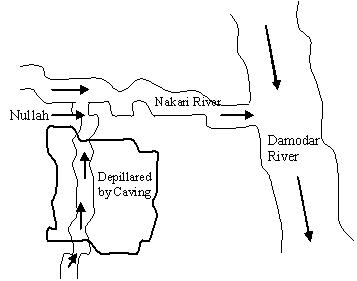Envis Centre, Ministry of Environment & Forest, Govt. of India
Printed Date: Friday, August 1, 2025
Central Saunda Colliery on 16.9.1976
Central Saunda Colliery
| Date of the Accident |
- 16.9.1976 |
| Number of persons killed |
- 10 |
| Owner |
- Central Coalfields Ltd. |
| Place |
- South Karanpura Coalfield |
Water from the flooded Nakari River entered the underground workings in Hathidari seam through cracks in the subsided goaf area. One of the fire stoppings, 1 m thick, built to isolate the goaf, gave way due to pressure of water and the accumulated water of the goaf flowed out to flood the dip workings. Ten persons who had gone to withdraw the dip side pump were drowned.
There was continuous heavy rain on 15th September night and the water level of the Damodar at its confluence with Nakari river rose dangerously. This resulted in rise in the level of the Nakari as also the “nallah” which discharged into Nakari. Water of the “nallah” overflowed its embankment and entered the subsided Hathidari goaf area through which it got into the underground workings. The workers who could come out of the incline against the gushing water reported that water was flowing in through an opening about 1 m x 0.75 m at the 15th level. Initially the flow was slow but soon the rush of water increased and there was danger of their being swept away by the force of water. Ten persons at the pump site in 23rd level could not come up and were all drowned by the gushing water.

Many factors contributed to this disaster. They are:-
- The big “nallah” passing over the Central Saunda property was not shown on the underground plan and development of Hathidari seam had been done ignoring the presence of this “nallah”.
- The application for permission to depillar did not show the small “nallah” flowing directly over the area to be depillared. In fact, the management carried out depillaring operations directly under the small “nallah” without the knowledge of the Inspectorate.
- The highest known flood level in the mine area was ignored.
- No watch was kept on the rising level of water in the rivers.
- Workers were employed belowground on the day in spite of dangerous rise in the water levels of the rivers.